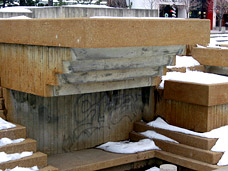
Nicollet Mall
Minneapolis, Minnesota
Peavey Plaza Minneapolis, Minnesota
Threat
Peavey Plaza, dedicated in 1975, is far from the fifty-year threshold for historic designation that is outlined in National Register of Historic Places guidelines, but it attracts the interest of both preservationists and landscape architects nonetheless. For example, the Preservation Alliance of Minnesota, a statewide nonprofit group, named Peavey Plaza to its “Most Endangered” list in May 2008 while the Minnesota Chapter of the American Society of Landscape Architects has been working to document Peavey Plaza to Historic American Landscapes Survey (HALS) standards.

However, Peavey Plaza is faced by a number of threats, not the least of which is a general lack of understanding of its National significance.
This shortsightedness is exhibited by both its owner, the City of Minneapolis, and its neighbor, the Minnesota Orchestral Association. The problem is not helped by the high level of maintenance that some of its features demand, especially given Minnesota’s challenging winters.
In a city where indigents are usually few and far between, Peavey Plaza’s downtown location sometimes attracts a concentration of this population. While this is more a management than a design issue, the design often gets blamed. The Minnesota Orchestral Association, understandably enough, does not want the plaza’s varied population to discourage people from attending events at Orchestra Hall. One idea that civic leaders have proposed is to transfer ownership of Peavey Plaza from the city to a private entity, perhaps the Orchestral Association. This would undoubtedly result in restrictions of the plaza’s use and would remove public oversight from proposed modifications to the design—very unfortunate outcomes that could substantially change the plaza’s character and set dangerous precedents. At the same time, the association wants to expand Orchestra Hall’s lobby. According to a February 2008 news article, the chair of the orchestra’s board of directors, Paul Grangaard, “envisions a glassy exterior with a dramatic downtown view. ‘Our goal is that the lobby will have a significant tier with northwestern exposure so people could see the sunset, the cupola of the basilica, the downtown skyline.’” Given the constraints of the site, such an expansion might significantly alter the historically significant Modernist landscape that is Peavey Plaza.